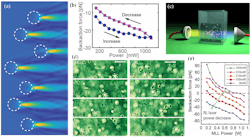Cell classification can be achieved via optical detection and manipulation of many cells within a short window of time, with high sensitivity, but large-scale manipulation with light is a challenge. Cells can be approximated as spherical or elliptical dielectric microparticles, and the refractive index of most cells tends to be greater than their surrounding medium. So cells can focus light into narrow photonic nanojets—high-intensity light beams.
A team of researchers from China, Singapore, and Hong Kong are harnessing microparticles’ ability to concentrate light because the strength of the electric field inside a photonic nanojet can be significantly enhanced.1 Liquid molecules take up energy and gain kinetic energy, and part of this momentum gets passed along to dielectric microparticles. This causes microparticles to go to the light source.
“In contrast to a cavitation bubble with an ultrafast laser, our method uses a much gentler light dosage to create backaction on dielectric particles,” says Kenneth Kin-Yip Wong, a professor of electrical and electronic engineering at the University of Hong Kong. “The radiation pressure force pushes particles forward, while the pulling of particles uses light (a backaction force), which plays a hitherto unsuspected role in manipulating microparticles.”
Wong and colleagues observed nonlinear hysteresis—a phenomenon in which the value of a physical property lags behind changes in the effect causing it—on the backaction force. This means a nanojet with an augmented electric field raises the local temperature of solvent molecules inside the nanojet. Once a microsphere moves to the next position, heat inside the nanojet eventually dissipates to the environment and contributes to the global temperature change inside the chamber.
“The response difference of the local and global temperature results in nonlinear hysteresis,” says Cheng-Wei Qiu, a professor of electrical and computer engineering at the National University of Singapore. “Hysteresis behavior was corroborated in both dielectric polymer spheres and biological cancer cells. And force hysteresis can be used to reverse the force direction in the presence of two counter-propagating beams.”
Earlier, the team conducted an experiment with a mode-locked, picosecond-pulsed laser. But this time, they demonstrated that a laser with continuous-wave operation can also pull dielectric particles.
“Our work was verified at different wavelengths between 1 to 2 µm, which suggests high water absorption,” says Yu-Xuan Ren, a research associate professor at Fudan University’s Institute for Translational Brain Research. “This suggests the possibility of using two counter-propagating beams with different spatial-temporal profiles to balance the backaction force.”
Single-beam optical tweezers exert force on microparticles and can detect the displacement with high precision, but challenges arise when it comes to increasing the throughput. “Parallelization via holography can produce an array of traps with an increased power budget, but it’s still insufficient for high-throughput, single-particle classification applications because of the beam control complexity,” says Wong.
A conventional negative photophoretic force relies on the temperature gradient induced by two sides of a particle with different responses to light, a.k.a. a Janus particle. The nanojet-mediated force takes place with homogenous dielectric particles—without complex fabrication.
Parallel manipulation
The team’s video snapshots (see figure) show cells can be manipulated by counter-propagating beams with reversible direction. “Although we marked a single cancer cell with a dashed circle, all the cells within the field of view move in parallel toward the light source of the strong beam,” says Ren. “The photonic nanojet-mediated optical backaction force provides this parallel manipulation superiority.”
They also made an observation about the history-dependent backaction force that may help them design a photonic device with biological materials. “Colloidal hydrodynamic suspension provides a novel platform to explore the nonlinear phenomenon,” explains Wong. “And parallel manipulation enables the creation of photonic devices using massive biological cells and, most importantly, parallel manipulation has no restriction in terms of spatial region.”
Wide-ranging applications
Biological settings provide “abundant dielectric particles—cells and organelles—ranging from nanometers to hundreds of microns,” says Ren. “Using light to remotely control cell motion and to detect motion behavior is of utmost importance for cancer cells, and it relies on a plethora of biological hallmarks to delineate its key features.”
As far as applications, “large-scale control over a nanoswimmer can be used to design targeted drug-delivery systems,” says Wong. “Our observation can also be used to construct dynamic optical matter and study the nonlinear bistability and hysteresis of a soft matter system.”
Hysteresis on the backaction force may potentially be used for optical memory, data storage, or optical bistability, thanks to the soft matter suspension of dielectric microparticles. This behavior provides new insights into novel mesoscale devices using soft matter that can be reconfigured by light.
Next, the team plans to explore the light-matter interaction with a grafted particle or particle coated with structured plasmonic layers, along with spatially and temporally structured light.
REFERENCE
1. Y.-X. Ren et al., Nanophotonics, 11, 18, 4231–4244 (Aug. 9, 2022); https://doi.org/10.1515/nanoph-2022-0312.

